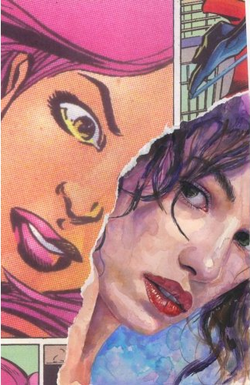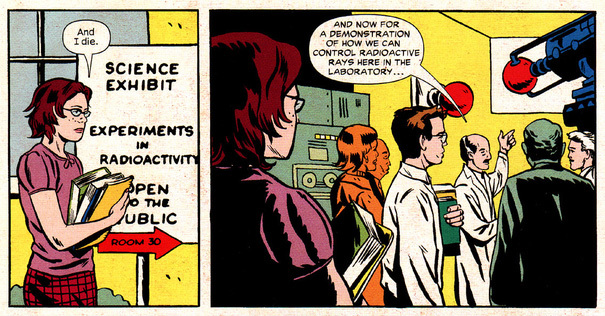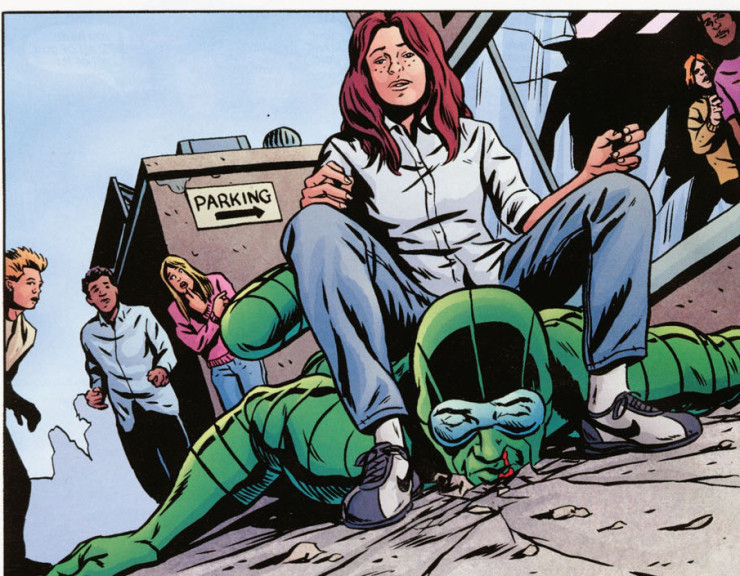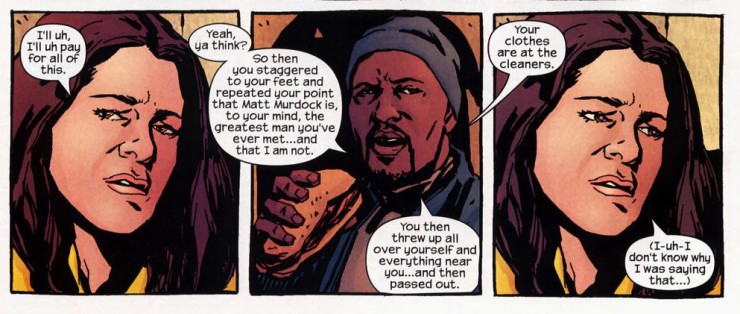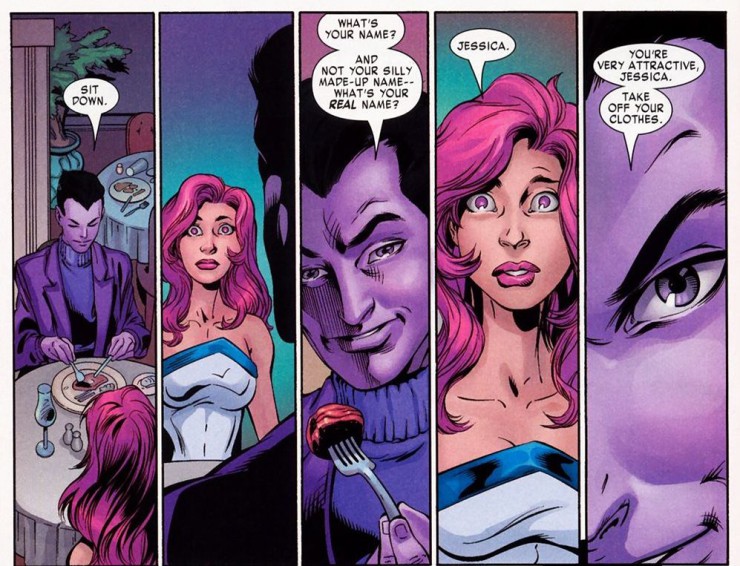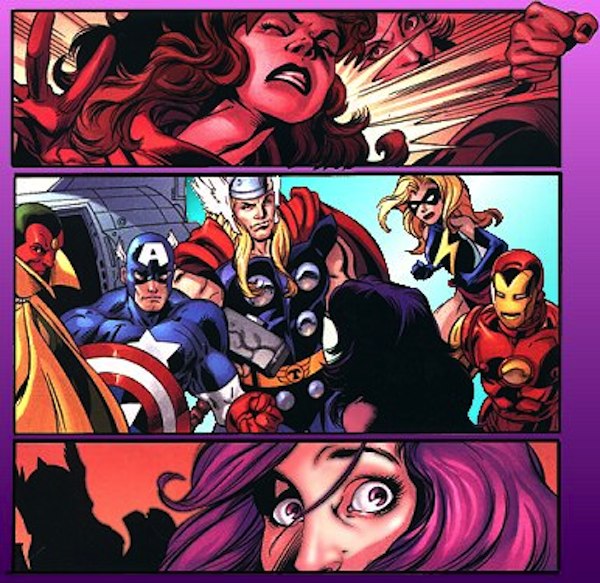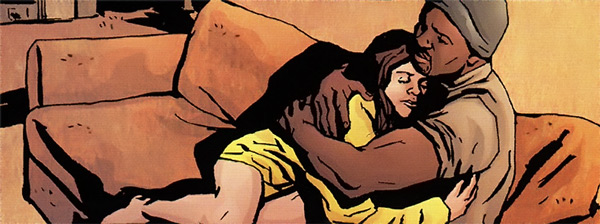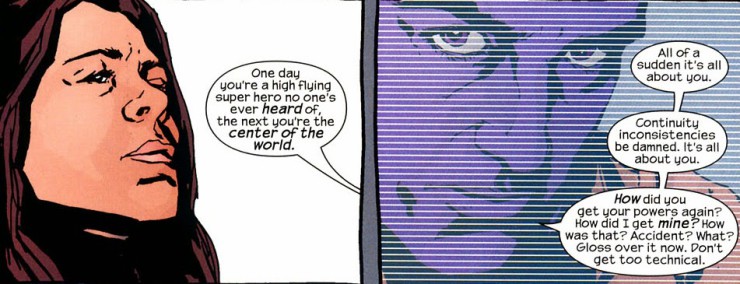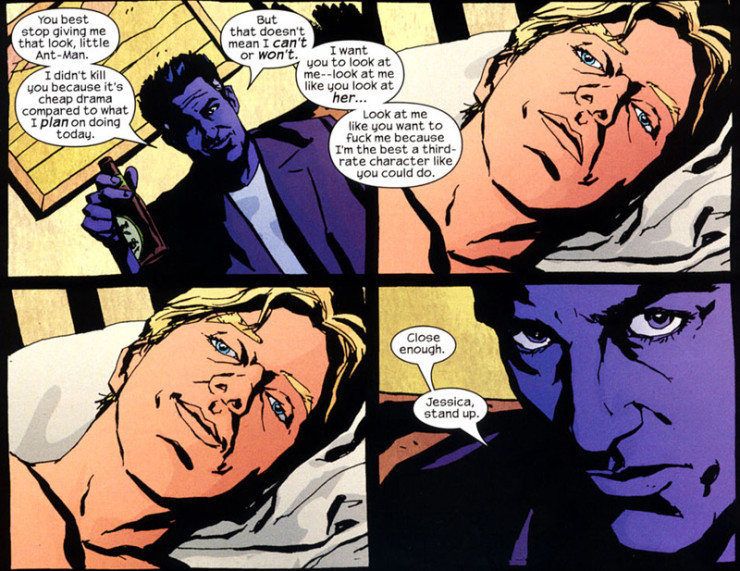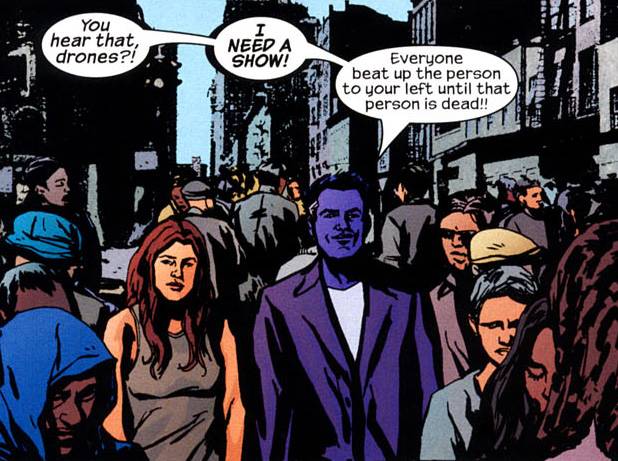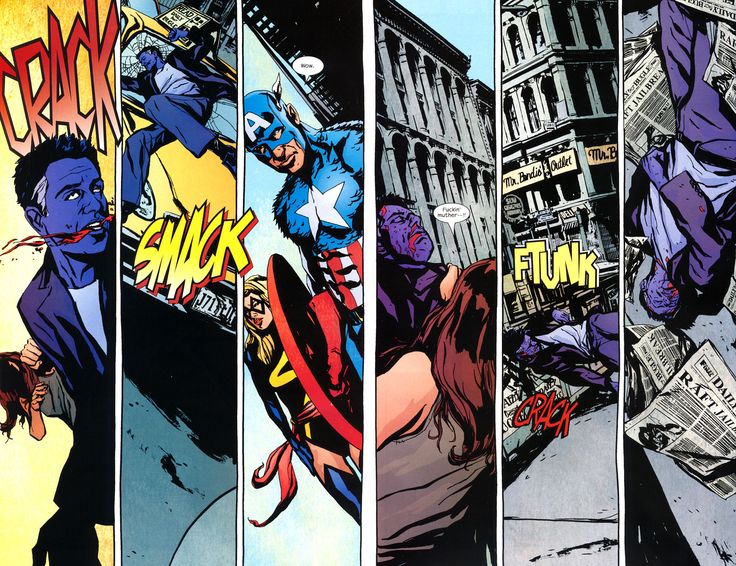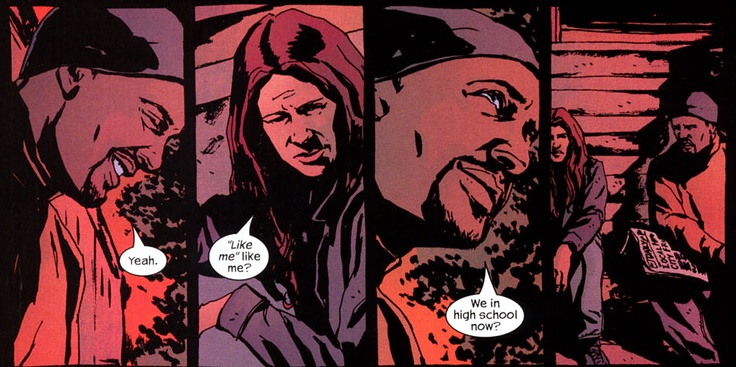Welcome back to the Alias re-read!
Previously in Alias, superhero-turned-private-detective Jessica Jones scammed Daily Bugle editor J. Jonah Jameson out of several months of charity donations, then rescued his teenage superhero foster daughter from a mutant growth hormone drugs ring, with help from the original Spider-Woman Jessica Drew. Jessica also acquired, then lost, then regained, official boyfriend-girlfriend status with Scott Lang AKA Ant-Man.
We’re on the final run of Alias now with the issues collected in the fourth trade. Given the casting of David Tennant as Killgrave/the Purple Man, this is very likely to be the most important story arc to viewers of next month’s Netflix release, Jessica Jones.
“Purple” is one of the most critically acclaimed storylines of Alias, but it’s also the story that brings all the threads together and makes the complete run of the comic feel like a graphic novel rather than an ongoing serial. It’s clear Bendis had this particular storyline in mind from the start, as there have been so many visual clues and lines of dialogue leading to this point. Given how deeply sinister and awful the Purple Man is in this story arc, I’m prepared for the fact that I’m never going to be able to look at David Tennant the same way again. Are you?
Alias: The Secret Origins of Jessica Jones (#22-28)
Issues #22-23
THOR: Young maiden of Midgard, thy language leaves something to be desired.
Changing up the artists/art styles to convey narrative or tonal shifts has been a characteristic feature of Alias all along—but this storyline has my absolute favourite use of that technique. It’s all the more clever because they haven’t brought in another artist this time, it’s 100% Michael Gaydos proving his versatility.
The issue opens “Fifteen Years Ago” in a school sequence, but not just any school—this is Midtown High, the same school that Peter Parker went to. The pages have a gorgeous retro sensibility to them: the layouts, linework and colours scream ‘1960’s Spider-Man comics’ and the first page acknowledges this with the artist signature: after DITKO.
(Steve Ditko was the original Spider-Man artist and co-creator with Stan Lee)
There are so many in-jokes here—Jessica went to the same high school as Peter Parker, which means she went to high school “fifteen years ago” but also in the 1960’s (because of the compression of time in the Marvel Universe to keep the characters young).
We see geeky teen Jessica mooning after Peter Parker, surrounded by teenagers using phrases like ‘hey gang!’ and ‘that bookworm wouldn’t know a cha-cha from a waltz!’ She’s right there on the school visit when her crush is bitten by the radioactive spider, though she doesn’t understand the significance of the moment. In another vignette, her annoying younger brother barges into her bedroom while she is thoughtfully masturbating to a very clean-cut poster of Johnny Storm.
All typical teen stuff, up until the point that her family are killed in a collision with a Hazardous Radioactive Materials truck (honestly, they were all over the place in the 1960’s, you couldn’t cross the road without become an accidental superhero).
Jessica awakes in a hospital after a six month coma, and the first thing she sees is supervillains attacking the Baxter Building across the city.
Returning to Midtown High a year after the accident, now fostered/adopted by the Jones family, Jessica is bullied by Flash Thompson and the others for being “freak coma girl.” She is about to descend into full Daria emo-ness when Peter Parker unexpectedly speaks to her for the first time.
Being our Jessica Jones, she promptly unleashes her temper at him, furious at his pity. So many swear words, you guys. So angst. Much teen.
As it turns out, much superpower too. In her rage, Jessica accesses superflight, and experiences the first of many crash landings. Drowning in a lake, she is rescued by a beautifully retro Thor—a Thor we’ve seen before in Jessica’s dream state, always reaching out to her, the idealised heroic figure.
What would you do if you had superpowers? Would you choose to be a hero? Teenage Jessica decides that yes, that’s exactly what she chooses to be.
This is her origin story: not only how Jessica got her powers and chose to use them, but the first sparks of her anger, her self-hatred and her pain—and in Peter Parker, the first instance of Jessica Jones scaring away someone she likes as a defence mechanism.
Incidentally, in Bendis’ later New Avengers run, there’s a scene where Spider-Man (having already publicly outed himself in Civil War) reluctantly unmasks in front of his colleagues, and Jessica flips out (in a cute way) when she realises he’s her old crush from high school. It’s the only time you’ll ever see Jessica Jones come close to squeeing.
Issue #24
JESSICA JONES: Dude, no offense, but I don’t even go over the Queensborough Bridge because I’m scared the Green Goblin might drop someone on me. So, there’s, basically, no way in hell I am going into the jungle to fight dinosaurs because you lost your cat.
Back in the present day, Matt Murdock introduces Jessica to a potential new client: Lord Kevin Plunder of the Savage Land. Once Jessica realises that the case involves a missing sabretooth tiger and a cargo plane to the middle of the Arctic, she refuses. She has some standards! (This is not a superhero book. Jessica rejects your genre!)
Back at Alias Investigations, she gets a message from a woman called Kim, representing a group looking for information on Killgrave, AKA the Purple Man. They were referred directly to her from the Avengers. Jessica is stunned and sickened by this—physically as well as emotionally, throwing up before she goes to the Avengers Mansion to scream at her on again off again BFF Carol Danvers (Ms Marvel)—how dare she do this?
Carol has no idea why her friend is so upset over a chance to get closure about the whole Purple Man thing. While Jessica is still in mid-rant, Captain America offers tea and her tiny Ant-Man boyfriend buzzes past to offer sympathy.
It’s all too much. Jessica runs, only to have Scott pursue her and grow to full size beside her in the backseat of the cab. He assures her that he knows all about what happened with Killgrave and it’s fine, nothing to worry about, Captain America vouched for her. No one has done anything wrong.
There’s a massive disconnect going on between what Jessica is feeling, and what everyone else thinks she should be feeling. Even without knowing (as I do, cos it’s a reread) the story behind the story, the whole thing has creepy gaslighting vibes.
JESSICA JONES: I’ll call you later. Respect my fucking boundaries.
Jessica goes to meet Kim’s group. In an inversion of what we normally see in the ‘interview a client” stripped panels, it’s Jessica who answers their questions about Killgrave.
The Purple Man’s superpower is the ability to overcome the will of anyone, and make them do/say/think literally anything. He is currently in a maximum security prison for super-villains, removed from society.
Kim and the others are the families of the victims from a specific Purple Man killing spree—he entered a restaurant, ordered some eggs, then ordered everyone inside (except the chef cooking the eggs) to stop breathing. While he has happily taken credit for all manner of horrendous crimes, he has never acknowledged responsibility for this incident.
The families need Jessica to help them get closure.
Jessica, looking miserable, says “yes.”
Issues #25-26
LUKE CAGE: Girl, how much shit from you am I supposed to take?
Jessica awakes a drunken blackout, in her underwear. She doesn’t know where she is, and can only hope she didn’t go home with a stranger…
The clues sink in. The bright yellow shirt in the wardrobe. The ironic retro Say No To Drugs poster featuring Iron Fist and Luke Cage.
In the absence of her clothes, she commandeers Luke’s shirt.
Because Luke is an awesome friend, he teases Jessica ruthlessly while recounting the events of the night before: how she drunk dialled him, then flew in his window and crashed into his fridge (check out the dent), and repeatedly lectured him about the awesomeness of Matt Murdock.
Luke making fun of Jessica is way more entertaining than Scott and Carol teaming up to lecture her about her emotional needs, just saying. Jessica knows it too—Luke is probably the best friend she has. So he’s the one who gets to hear her story.
“Purple Haze” is laid out as a “Stan Lee Presents: Jewel” story. As with previous Jewel flashbacks, the art is done by Ultimate Spider-Man’s Mark Bagley, with a much brighter color palette than we usually see in Alias. That sneaky superhero genre, it is invading our serious comic!
When I say bright, I mean purple and pink—the bubblegum colours of Killgrave’s skin and Jewel’s hair contrast wildly with the content as Jessica Jones has her first encounter with the grossest supervillain of them all. When the Purple Man turns his powers on her, Jewel loses all consent and free will. He orders her to take off her clothes, and she complies until he sends her to attack the approaching police.
In between the Jewel scenes we flick back to the dark, simple character panels of Luke and Jessica as she tells him the truth of what Killgrave did to her. He had her for eight months. He never raped her—this is a much more nuanced conversation than we got when Scott raised the same question—but he took away her sense of self, and she is still damaged by it, years later.
In a series of brutally honest character moments, Jessica describes how Killgrave used his powers on other women and made her watch—how he made her cry and beg and want him to do it to her. Together she and Luke unpeel the layers of the story—how guilty Jessica feels (still) because of the things she thought and did while under the influence of Killgrave. Add to that the bleak realisation that no one really noticed or cared she had been gone eight months (it irretrievably broke her relationship with her adopted mother, for example) and our Jessica Jones makes a lot more sense.
The second part of the Jewel flashback shows how Killgrave eventually went into a rage about Daredevil and sent his pet Jewel to go kill superheroes—finally, out of range of his chemical bombardment, she started coming out of his mind control. Still dazed, she continued on her mission, arriving at Avengers mansion just as the heroes and their pals arrived home from a cosmic mission… and Jewel, “some costumed bimbo” attacked the first Avenger she saw, the Scarlet Witch.
Of course, they attacked her back.
Thor—her hero, the one who rescued her as a kid and made her want to be a superhero—chased Jewel across the skies of New York, fighting her. The other Avengers followed. Carol was the only one trying to stop them, but she couldn’t prevent Jessica being pummelled.
Cue: Coma no. 2, in which a brainwashed and exhausted Jessica checks out mentally, taking refuge in a dream state drawn by Rick Mays. Some time later, Jean Grey of the X-Men uses therapeutic telepathy to communicate with Jessica. Daredevil caught Killgrave, and it’s all over. She wakes up, with a jarring shift to the Michael Gaydos art we know, and the familiar sight of our normal, banged-up, everyday Jessica Jones.
There are more pieces of the puzzle to be found here: how Jessica met and bonded with adorable SHIELD agent Clay Quartermain, and how the guilt-ridden Avengers begged her forgiveness for the misunderstanding. How SHIELD offered her a job, and the Avengers offered her auxilary member status… all of which felt like a payoff.
This is why Jessica Jones chose not to be an Avenger any more.
Incidentally, if you’re not shipping Luke and Jessica after watching him listen and support her through all this, the two of them inching closer and closer together on the couch, then you did it wrong, go back and read it again.
The power in this story is that Killgrave is barely present—I’d forgotten how little he appears. It’s all about the impact of what he did, and how Jessica feels about it. The Avengers forgave her and moved on from the incident (which is why Carol thinks she should be over it), but Jessica couldn’t forgive herself, because she still remembers doing and thinking anything the Purple Man told her to, and she remembers liking it.
After her talk with Luke, Jessica arranges to go to the Raft, the secret supervillain prison, and visit Killgrave on behalf of Kim and the others.
CLAY QUARTERMAIN: Sure you don’t want me to stand behind you and look badass?
JESSICA JONES: I wore my leather jacket so I think I got it covered.
Issue #27
PURPLE MAN: Something really bad is going to happen to you, Jessica. I wouldn’t turn to the end. I bet something really horrible happens.
So, this is super creepy. Jessica approaches Killgrave’s cell for their conversation—shielded from his chemically-induced powers—but while she sticks to business, trying to address the issues of her clients, he narrates the scene like he’s scripting a comic book.
It’s cute when She-Hulk or Deadpool do it. Killgrave is not cute.
His monologue points out the inconsistencies in Jessica’s world—how she came out of nowhere, a superhero no one has ever heard of, and the story still revolves around her. (Oh, meta. Why do you have to be so sinister?)
Jessica gives up in disgust. Clay comforts her on the roof and she goes back to Kim to admit she failed- only to see on the news that the Purple Man escaped soon after their meeting.
Way to implicate her! Kim assumes the worst of Jessica, and she won’t be the only one.
Jessica goes into lockdown—calls her mother to send her somewhere safe, fires her boy assistant to get him the hell out of the office, and finally accepts a call from Clay… but she can’t trust that he isn’t already under Killgrave’s influence.
Freaked out and paranoid, she spends the night with Scott, only to wake up and discover him dead in the bed beside her, his corpse covered in ants that are eating him alive.
Yeah, I’m pretty sure they’re not gonna do that scene in the Netflix show.
Issue #28 (last issue, OMG!)
PURPLE MAN: Subtle yet expressive artwork. Mainstream with just a touch of indy. Seen worse. Been in worse. Jessica, please be quiet! You’re annoying me already and it’s only page one.
Okay, so Scott’s not dead. Killgrave made Jessica see him that way. Scott is, however, completely controlled by the Purple Man, paralysed on the bed.
There’s a squicky part where Killgrave orders Scott to smile at him like he would at Jessica, and he does, and it’s SO CREEPY OMG but also a very pointed piece of gender commentary, because when do men ever get told they’re not smiling enough?
The next hallucination Killgrave creates for Jessica (whom he repeatedly calls whorish because he is a jerk and seriously, this is going to ruin David Tennant forever, it’s bad enough that the internet is already full of images of him all purpled up) is what he believes to be her worst nightmare: her friend Carol having a threesome with Luke and Scott. They’re all in uniform.
Really now? That’s what you think of Jessica? Sure, she has trust issues, but I’m pretty sure Jessica’s worst nightmare is actually this: being back under Killgrave’s control.
As they walk down the street with him casually causing pedestrians to murder each other, Jean Grey appears in a psychic projection. Jean Grey, you are the literal best!
Turns out that Jessica was so worried about the possibility of Killgrave taking control of her again, that Jean gave her a psychic distress trigger in their therapy work together. She has a choice now, to release herself from Killgrave’s control.
In a beautiful, beautiful scene, the Avengers (or as the Purple Man calls them, the big crossover teamup), assembles to save the day (and Jessica Jones), calling for Killgrave’s surrender. He orders Jessica to kill one of them—her choice. Though if she refuses to pick, he’s totally into the idea of her breaking Captain America’s back.
We’ve got used to Jessica’s face over the last 28 issues, which means we don’t need to be told at all what she’s thinking as she looks at him.
And then she beats Killgrave senseless.
Captain America is impressed. Ms Marvel is delighted. The Purple Man is returned to his high security prison (though I feel more questions should be asked about how easily he escaped). It might be anti-climactic, but closure is had by all.
Scott Lang’s hoping for a happy ending, but Jessica chooses now to tell him about something that has been only subtly alluded to over the last, well, many issues (you can see it if you’re looking for it)—she’s three months pregnant, which predates their relationship. Knowing he’s not the father, he walks away.
Let’s hope it’s not the creepy sheriff.
Just kidding, it’s totally Luke’s baby, that kid is one of the most famous children in the Marvel Universe.
Alias ends as it began—with Luke and Jessica giving each other shit. The scene in which they both have something important to tell each other is pretty damned adorable. I ship them so hard.
If you’re reading Alias in the shiny Omnibus hardcover, it includes a whole lot of great supporting material including author interviews, musings on the role of different artists on the book, sketches, script details and so on.
There’s also a one-off issue, What If Jessica Jones Joined The Avengers (2004) which explores an alternate universe she took that job offer after her second coma. It has some cute elements, like getting to see Michael Gaydos draw Jewel (bizarre how wrong it looks to see Jessica’s Gaydos face on Jewel!) and Jessica as a SHIELD agent. We’re also shown how this might have made all the difference to the Avengers Disassembled storyline, if Jessica noticed the Scarlet Witch’s disturbed mental state before she went off the deep end, warped reality and killed a bunch of people.
But the story sets up a surprise romance between Jessica and Captain America, which feels weird and tacky to read right after we got things sorted with Luke. If you do have that book, take a break after the final proper issue before you check that out! Like a couple of years or so.
Jessica Jones did return—if you’ve read through Alias, you can follow her continuing adventures in The Pulse, Young Avengers Vol. 1, New Avengers Vol. 1 and 2, and The Mighty Avengers all written by Brian Michael Bendis. And of course, she will be appearing in the upcoming Netflix TV series on November 20, played by Krysten Ritter.
We’ve got one more post in the Jessica Jones reread, leading up to the Netflix premiere, so check back here next week!
Tansy Rayner Roberts is a Marvel Comics tragic, and a Hugo Award winning blogger and podcaster. Tansy’s latest piece of published short fiction is“Fake Geek Girl” at the Review of Australian Fiction, and she writes comics reviews on her own blog. You can find TansyRR on Twitter & Tumblr, sign up for her Author Newsletter, and listen to her on Galactic Suburbia or the Verity! podcast.










